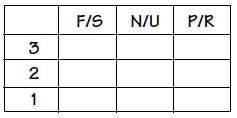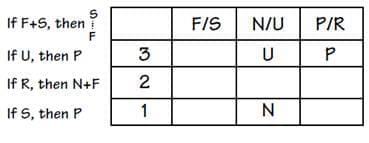Practice Question - 39 (Tabular Arrangement) | 100 DILR Questions for CAT Preparation PDF Download
At an automobile exhibition, cars are displayed on each floor of a three-floor building. On each floor the cars are either all family cars or all sports cars, either all new or all used, and either all production models or all research models. The following conditions apply to this exhibition:
If the exhibition includes both family cars and sports cars, then each family car is displayed on a lower numbered floor than any sports car.
I. The exhibition includes no used research models.
II. The exhibition includes no research models that are sports cars.
III. There are new cars on floor 1.
IV. There are used cars on floor 3.
1. If there are sports cars on exactly two floors, then which one of the following statements could be true?
A. There are research models on floor 1.
B. There are sports cars on floor 1.
C. There are family cars on floor 2.
D. There are research models on floor 2.
E. There are family cars on floor 3.
2. Which one of the following statements could be true?
A. The exhibition includes new research model sports cars.
B. The exhibition includes used research model family cars.
C. The exhibition includes used research model sports cars.
D. There are research models on exactly one floor.
E. There are research models on all three floors.
3. Which one of the following statements must be true?
A. There are production models on floor 1.
B. There are research models on floor 1.
C. There are production models on floor 2.
D. There are production models on floor 3.
E. There are research models on floor 3.
4. If there are research models on exactly two floors, then which one of the following statements can be false?
A. There are family cars on floor 1.
B. There are research models on floor 1.
C. There are new cars on floor 2.
D. There are research models on floor 2.
E. There are family cars on floor 3.
5. If all the new cars in the exhibition are research models, then which one of the following statements must be true?
A. All the family cars in the exhibition are new.
B. All the family cars in the exhibition are research models.
C. All the family cars in the exhibition are used.
D. All the new cars in the exhibition are family cars.
E. All the production models in the exhibition are family cars.
6. If all the production models in the exhibition are used, then which one of the following statements must be true?
A. There are family cars on floor 1.
B. There are new cars on floor 2.
C. There are research models on floor 2.
D. There are family cars on floor 3.
E. There are sports cars on floor 3.
 View Answer
View Answer 
The Action: This fairly complex set involves matching cars with 3 different characteristics (family or sports car, new or used, and production models or research models), and then with a fourth characteristic, the floor they’re displayed on. Important to note that each floor contains all or one of each of the three different characteristics, i.e. there will not be both new and used cars on a single floor. There’s only one major Key Issue that every question will involve: 1) What characteristics are exhibited by the cars on each floor?
The Initial Setup: Since we're dealing with 3 floors each containing 3 characteristics, one possible way to visualize this is to draw a 3 by 3 table. We can label the vertical side of the box 3, 2, and 1, from top to bottom, and each box across horizontally would represent one of the three characteristics: style, age and type. This way we can picture each floor and it's relevant traits:
The Rules:
Where to start? As usual, with the concrete rules.
4) The cars on floor 1 are new. An “N” in the appropriate grid box will remind us that ALL of the cars on floor 1 are new.
5) The cars on floor 3 are used. A “U” in the appropriate floor 3 grid box means that all the cars exhibited there are used.
1) This rule is fairly lengthy, so take you r time and be sure that you fully understand it. IF (that’s a big if) there are both family and sports cars, then all of the family cars will be on lower floors than any of the sports cars. So if there are both kinds, floor 1 must be family cars and floor 3 must be sports cars. Understanding this rule is far more important than exactly how you choose to represent it on the page.
2) There are NO cars that are both used and research models. What does this tell us? If a car is used, then it must also be a production model. If a car is a research model, then it must be new. If a car is new....nothing. Be careful, a new car can either be a research model or a production model. “If U, then P” and “if R, then N” should help us remember this.
3) None of the cars in the exhibition are both research models and sports cars. Again, be careful when considering what this means. If a car is a research model, then it must be a family car. If a car is a sports car, then it must be a production model. If a car is a family car or a production model, then we know nothing (or at least nothing new). “If R, then F” and “if S, then P” will aid in sorting it out.
Key Deductions: The results of our work with Rules 2 and 3 certainly qualify as “Key Deductions.” However, there's even more to piece together. Rule 2 yielded “if Research, then New,” and Rule 3 yielded “if Research, then Family.” To make it easier we can combine those to get “if Research, then New and Family.” Also, don’t neglect your grid. Rule 5 resulted in a big “U” under floor 3, and thanks to Rule 2, we know that “if Used, then Production.”
Therefore, the floor 3 cars must be production models. Two of the three characteristics are taken care of for that floor. The Final Visualization: Here’s what we have just before facing off with the questions:
Ans. 1 (A)
If sports cars are on exactly 2 floors, then family cars must be on exactly 1 floor, and Rule 1 applies: Sports cars must be on floors 2 and 3, which eliminates choices (C) and (E), and family cars must be on floor 1, which contradicts choice (B). Floors 2 and 3 contain sports cars which are production models (Rule 3). Choice (D) is therefore out. Only choice (A), research models on floor 1, is possible.
Ans. 2 (D)
No new information here, so move right on to the choices. Rule 2 kills choices (B), (C) and (E), since we know that at least one floor has used cars. Rule 3 axes choice (A). We’re left with choice (D), and it is indeed possible that exactly one floor has research models (as long as that floor is floor 1 since it would have to contain new research model family cars).
Ans. 3 (D)
Another non-if, this one a “must be true” with no new information. A quick scan through the choices in search of one of our earlier deductions turns up choice (D)—production models on floor 3. (A), (B), and (C) are possible only, while (E) is totally impossible.
Ans. 4 (E)
Since we deduced that floor 3 contains production models, the 2 floors with research models must be floors 1 and 2. A quick glance at your scratchwork tells you that these research cars must be new family cars (Rules 2 and 3). Notice that this takes care of eight out of the nine possible boxes in our table. Also notice that the question is a “can be false” question. Here’s where the on-the-ball test-taker realizes that it’s a good bet that the answer to the question will almost certainly deal with the one box that’s still unresolved, which deals with the family/sports issue on floor 3 (everything else is determined, and therefore must be true). Choice (E), family cars on 3, could be false, and therefore does the trick. Choices (A) through (D) correspond perfectly to the situation, so naturally they all must be true.
Ans. 5 (D)
Rule 3: All research cars are family cars. Stem: All new cars are research cars. Therefore: All new cars are family cars, which happens to be choice (D). Family cars need not be anything in particular, so choices (A) through (C) are out. Similarly, in (E), a production model car could be a sports car.
Ans. 6 (A)
If all production models are used, then a car that is not used (new), must not be production (research). So floor 1’s new cars must be of the research variety, which means that floor 1’s cars must also be family cars (Rule 3). We get this in choice (A). (B) through (E) all could be true, but also could be false
|
102 videos|123 docs|121 tests
|
FAQs on Practice Question - 39 (Tabular Arrangement) - 100 DILR Questions for CAT Preparation
| 1. What is the structure and format of the CAT exam? |  |
| 2. How should I prepare for the CAT exam? |  |
| 3. What are the eligibility criteria for the CAT exam? |  |
| 4. What are some common mistakes to avoid while taking the CAT exam? |  |
| 5. How is the CAT exam scored, and what is the significance of the percentile? |  |




















